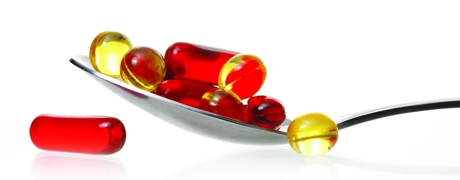Features
Vitamins: The ABCs & Beyond
Better science, greater consumer awareness and convenient product options will help drive the market into the future.
By: Brenda Porter

Despite all the noise associated with the Affordable Care Act and the troubled rollout of HealthCare.gov, vitamins continue to remain above the fray. In their own way, vitamins have always been an affordable and reliable insurance policy.
Generally, multivitamins and letter vitamins are top choices for consumers. According to data from SPINS, Schaumburg, IL, sales of most supplements with vitamins as the primary ingredient were up across both conventional and natural channels for the 52 weeks ending the last week of October 2013. In fact, overall, sales of vitamin supplements were up 9% to more than $1.5 billion, according to SPINS data.
Industry veterans contend that better science, ease of use and greater consumer awareness about the benefits of vitamins for continued well-being are among the top indicators for current and future sales boosts.
Steve Mister, president and CEO, Council for Responsible Nutrition (CRN), Washington, D.C., said there are more and more reasons to include dietary supplements in a healthy lifestyle, and more and more consumers are getting that message.
“While some of our detractors dismiss the positive research, the fact is that research is demonstrating that most Americans are not getting all their recommended nutrients from the foods they eat, so vitamins make sense to fill in those gaps,” said Mr. Mister.
Multi-Faceted Approach
Research is a double-edged sword. While good news helps bolster consumer awareness, and subsequently sales growth, other reports lead consumers to question the need for supplementation.
Case in point: this year’s Consumer Survey on Dietary Supplements, commissioned by CRN, revealed that the multivitamin remains the most identifiable dietary supplement among U.S. adults. Some 52% of respondents reported taking a multi in the last year.
In November 2012, news from the Journal of the American Medical Association, reported the results of a large-scale, randomized, double-blind, placebo-controlled trial of more than 14,000 U.S. male physicians 50 years or older, which found that taking a multi may reduce the incidence of cancer in men.
However, such welcome results may get lost in noise around unflattering studies, like the one published a year later in the Annals of Internal Medicine. The literature review of existing science concluded there is limited support showing that a multivitamin is a good preventive aid for cardiovascular disease or cancer. This, industry experts said, clouds the discussion about a supplements’ true nutritional role.
“Some of the headlines from the latest U.S. Preventive Services Task Force recommendations definitely misinterpret the report,” said Mr. Mister.
As part of the 2013 literature review, “Vitamin and Mineral Supplements in the Primary Prevention of Cardiovascular Disease and Cancer,” the researchers only identified two high quality clinical trials that investigated a link between cancer or heart disease and a multivitamin. The first looked only at men and found a small, but significant, reduction in cancer risk among those men who took a multivitamin. The other looked at both sexes and found a small, statistically insignificant reduction for men. The study was conducted by researchers at the Kaiser Permanente Center for Health Research to support the work of the USPSTF’s new draft recommendations.
“Based on the lack of additional research to corroborate those findings, USPSTF found insufficient evidence to make a broad recommendation for the use of the multivitamin to prevent cancer,” explained Mr. Mister, pointing out that numerous consumer surveys suggest most people take multivitamins to fill in nutrient gaps and to promote overall good health, not with the expectation of cancer prevention. “If future research demonstrates that link, it’s icing on the cake; another reason to take your multivitamin,” said Mr. Mister.
Dr. Cara Welch, senior vice president of scientific and regulatory affairs, Natural Products Association (NPA), Washington, D.C., noted, “We also do not believe a multivitamin should be expected to stand as the primary prevention of cancer or cardiovascular disease. However, the research did show some limited evidence that a multivitamin could prevent cancer. This is good news, in fact, but the authors chose to overlook it.”
The takeaway here is the multivitamin, now available as a more personalized approach to good health, remains the cornerstone of the consumer’s insurance policy for wellness. “We have noticed … more specialized formulas targeting more individual nutritional needs,” said Steve Watts, global product manager, Prinova, Carol Stream, IL, highlighting formulas like 50+, sports/athletes and kids nutritional products. “This is good for vitamin demand.”
Letter By Letter
While CRN’s survey is a boon for the industry, Paul Borrell, senior vice president of sales and marketing, Pharmachem Laboratories, Inc., Kearney, NJ, said he was surprised the use of multivitamins wasn’t higher. “We have been seeing strong growth in our vitamin business over the last five years, and I really expected the number to be higher.”
Vitamin D. Behind multivitamins, vitamin D usage among adults ranked second (20%), while vitamin C (17%) ranked fifth, according to the CRN survey.
“Vitamin D has been a hot item for the industry over the last few years, particularly because of benefits for the immune system and bone health,” said Mr. Borell. “Vitamin K has been growing, but we think that consumers are still learning about the benefits of this vitamin, so it will continue to show strong growth. New research has put vitamin D in a national spotlight as a good choice not only for bone health, but possibly for cardiovascular health, immune health and diabetes.”
In response to a meta-analysis published in The Lancet in early October 2013, “Effects of Vitamin D Supplements on Bone Mineral Density: A Systematic Review and Meta-Analysis,” CRN took issue with the conclusion that vitamin D, in the absence of calcium, did not show fracture prevention.
The association contended vitamin D is necessary for calcium absorption and bone density; therefore, the pair work together, providing a “protective effect for helping to prevent osteoporosis,” said Duffy McKay, vice president, scientific and regulatory affairs, CRN.
However, to unilaterally write off vitamin D as ineffective without the presence of calcium is a mistake, he said. “For populations that are most vulnerable to vitamin D deficiencies and insufficiencies—especially older adults—getting vitamin D from food alone is particularly challenging, and so supplementation may be warranted. We have concerns that the author’s broad-based advice will do nothing but cause potentially dire consequences if people, particularly those at-risk for fracture, fail to obtain the recommended daily intake of vitamin D.”
Vitamin K. With the undisputed easy recognition of the single letter vitamins—A, B, C, D and E—Eric Anderson, global vice president of sales and marketing, NattoPharma USA, Metuchen, NJ, said he is seeing “the strong and compelling emergence of the forgotten vitamin K, specifically K2.”
A September 2013 survey from Mintel revealed new product launches containing vitamin K2 have almost doubled (+183%) globally over the past five years, outpacing the more well known vitamin K1 (+90%) over the same reviewed period.
Laura Jones, global food science analyst at Mintel, explained, “Vitamin K1 has a relatively short half-life and is rapidly cleared from the blood, and is cleared by the liver within eight hours. In comparison, vitamin K2 has a longer half-life of up to 72 hours, meaning it remains biologically active in the body for longer. Vitamin K2 is also absorbed better by the body compared with vitamin K1. These factors, along with the additional health benefits linked to vitamin K2, should encourage the use of vitamin K2 over K1 when trying to correct vitamin K deficiency.”
NattoPharma and its university research partner, University of Maastricht in the Netherlands, have identified cardiovascular benefits of natural vitamin K2, in that it inhibits the progression of arterial stiffness. Nattopharma MenaQ7 brand K2 provides natural vitamin K2 (menaquinone-7 or MK-7) as a fermentation extract whereby vitamin K2 is manufactured using Bacillus subtilis natto or Bacillus licheniformis. NattoPharma has innovated MenaQ7 Crystals, which the company said are inherently more stable than other sources of vitamin K2 and offer several benefits to both manufacturers and consumers.
Vitamin E. Suppliers of natural vitamin E (alpha-tocopherol) said the supplement has been well accepted by the dietary supplement and cosmetic markets based on its general antioxidant, cardiovascular and reproduction health benefits.
However, negative science and resultant publicity on vitamin E [e.g., Selenium and Vitamin E Cancer Prevention Trial (SELECT) and Heart Outcomes Prevention Evaluation Study (HOPE)] has caused a drop in sales and new product launches.
Natural vitamin E has seen its ups and down, but suppliers said a coming upswing is an indicator of long-term forward trajectory. Vitamin E sales in the combined natural and conventional channel, according to SPINS data for the 52-week period ending Oct. 26, 2013 were down by about 2% from the previous year. However, looking at the natural channel alone, sales were up 6% from the previous year to more than $6 million; although same year sales dipped about 2.5% in the conventional channel.
Dietary supplement and cosmetic companies alike have started to embrace another form of vitamin E: tocotrienols.
“The trend in the market is that there is more to vitamin E than just alpha-tocopherol alone,” said Bryan See, regional product manager, Carotech Inc., supplier of Tocomin and Tocomin SupraBio brand vitamin E. He said research has found there are other natural forms of vitamin E such as tocotrienols. In nature and our diet there are eight forms of vitamin E—four forms of tocopherols and four forms of tocotrienols (alpha, beta, gamma and delta, respectively).
But now, the research on vitamin E has progressed to the point where important scientific breakthroughs on tocotrienols (the unsaturated form of vitamin E) affecting neuroprotection, cognitive health, cardiovascular support, skin and liver health, have created significant demand for tocotrienols. (For more information: www.tocotrienol.org.)
“There’s a comeback on the horizon and it will be led by science,” said Brian Stagg, director of sales and marketing, Americas, for Davos Life Sciences, Farmingdale, NJ, makers of Natural e3 tocotrienol. He said consumers want to make more informed choices; Davos is aiding that knowledge with a researched-based consumer website, www.tocotrienolresearch.org.
“It’s simply designed for the consumer to help them understand the science behind the natural form of vitamin E,” said Mr. Stagg, noting that the new food and drink applications for vitamin E will likely grab the attention of more users and greater sales.
B Vitamins. Another growth area among letter vitamins has been the B vitamin category. In the last five years, for example, B vitamins have expanded into new areas of nutritional development.
Choline, such as VitaCholine from Balchem, New Hampton, NY, falls into the B vitamin family as a precursor molecule for the neurotransmitter acetylcholine, which is involved in many functions, including memory and muscle control.
As reported in the September 2010 issue of the American Journal of Clinical Nutrition, a placebo-controlled study of pre- and postmenopausal women with low estrogen levels was undertaken to see which group was more susceptible to the risk of organ dysfunction if not given a choline-sufficient diet. The study found that among postmenopausal women, 73% who received placebo, but only 18% who received estrogen, developed organ dysfunction during the low-choline diet. The authors concluded that because of lower estrogen concentrations, postmenopausal women have a higher dietary requirement for choline than do premenopausal women.
Choline is also a protector of nitric oxide, critical to maximal muscle exertion during training and recovery. VitaCholine consists of USP-grade choline products for tablets, capsules, over-the-counter, medical nutrition and infant formula.
Niacin is another essential human nutrient in the B3 category. Recent studies indicate that vitamin B3 may also support healthy cholesterol and blood sugar levels. Bernie Szalkowski, business director, nutrition, Vertellus Specialties, Indianapolis, IN, noted a growing demand for supplements, and functional foods and drinks, is driving the inclusion of B vitamins, including B3, in formulations.
“The pre-mix market consistently formulates with B3 and this is where a lot of growth is now,” said Mr. Szalkowski. “For example, the energy drink market consistently has double-digit growth and B3 is a common ingredient in caffeine-free formulations which support the release of energy.”
Innovation Ahead
Functional foods/beverages offer convenience and affordability, according to Dana Brown, east coast sales manager for ingredient supplier Corbion Caravan, Lenexa, KS.
“Our lifestyle requires our food to be more portable and affordable, while not sacrificing nutrition. There is no easier way to accomplish this than by enriching foods we eat every day,” she said, suggesting the company’s Nutrivan line of vitamin and mineral pre-mixes for functional foods can help manufacturers offer consumers the convenience factor.
Sam Wright, IV, CEO of The Wright Group, Crowley, LA, noted that many vitamins are challenging from an organoleptic standpoint. “The Wright Group has been in the forefront of creating stable, good-tasting, value-added forms of these key ingredients.”
New applications such as shots, gels, strips, gummies, aerosols and creams have been a major change in product form, he added. “These appeal very much to an aging population who may have difficulty in swallowing tablets as well as millennial consumers who find them more convenient and appealing. New technologies such as microemulsions have also made it possible to incorporate oil soluble vitamins A, D, E and K into clear beverages for the first time. Microencapsulation technologies such as our SuperCoat line continue to push the limits of what is possible from a taste-masking and stability-enhancement standpoint, making new products possible.”
Prinova’s Mr. Watts also said packaging innovation has benefited consumers. “One development in recent years has been in packaging, such as bottle caps carrying required vitamin dosage for bottles of water. Not only is it convenient delivery, but it also keeps vitamins significantly more stable in dry form until they are ready to be consumed.”
Pharmachem’s Mr. Borrell noted that his company is seeing substantial growth and interest in organic whole food vitamins, which involves blending the vitamins with organic fruits and vegetables.
In the future, reaching consumers at an earlier age and keeping them as users for life, will be key to market growth, according to industry experts.
In 2013, CRN’s consumer survey added several questions to garner new insights into consumer usage and behaviors surrounding dietary supplements. One of the new questions asked supplement users, “When did you first begin taking supplements overall?” According to results, 73% of supplement users reported starting their supplement use in adulthood.
Nattopharma’s Mr. Anderson said young bones need vitamin K2 for healthy development. “Unfortunately, children are consuming nowhere near the amount of necessary K2 from foods. They are frequently fed Frankencheeses—chemical and colored concoctions that mimic cheese—as opposed to real, healthy fermented cheese, the best source of K2 in the western diet.”
Additionally, Mr. Wright noted the importance of the Baby Boomer market, which is looking to vitamins and supplements to maintain a healthier lifestyle and to lower their healthcare costs. “They’re shying away from pharmaceuticals, fearing side effects and turning to natural alternatives. New delivery systems, which make consumption and adherence easier than tablets or capsules, would likely resonate with the senior population.”
Brenda Porter-Rockwell has more than a decade of writing and reporting experience. She can be reached at brenda@writeonporter.com.
Trade associations respond to research and negative editorial published in Annals of Internal Medicine.
Long-term use of a daily multivitamin did not provide cognitive benefits in male physicians aged 65 years or older, according to a study published in the Annals of Internal Medicine. This randomized, double-blind, placebo-controlled clinical trial evaluated the efficacy of a daily multivitamin to prevent cognitive decline among 5,947 male physicians aged 65 years or older participating in the Physicians’ Health Study II. After 12 years of follow-up, there were no differences found between the multivitamin or placebo groups in overall cognitive performance or verbal memory.
Researchers noted that doses of vitamins may have been too low or the population may have been too well nourished to benefit from a multivitamin. However, Annals of Internal Medicine also published an editorial titled “Enough Is Enough: Stop Wasting Money on Vitamin and Mineral Supplements,” which discussed three recent studies that indicated no positive effect for vitamin and mineral supplements.
The editorial stated, in part, “Evidence is sufficient to advise against routine supplementation, and we should translate null and negative findings into action. The message is simple: Most supplements do not prevent chronic disease or death, their use is not justified, and they should be avoided. This message is especially true for the general population with no clear evidence of micronutrient deficiencies, who represent most supplement users in the United States and in other countries.”
Trade associations, including the Council for Responsible Nutrition (CRN) and the Natural Products Association (NPA), Washington, D.C., criticized the assessment.
“Multivitamins are not intended to cure chronic disease or prevent death solely on their own,” said Cara Welch, PhD, senior vice president of scientific and regulatory affairs at NPA. “They are designed to address nutrient deficiencies, and to aid in the general health and well-being of consumers. Multivitamins are not meant to serve as the answer to all of life’s ailments; they are, however, an important piece of the puzzle in leading a healthy lifestyle.
NPA’s CEO and Executive Director John Shaw said it’s “extremely unfortunate” that the “overblown” editorial misinformed consumers and attacked the dietary supplement industry. “It’s no secret that many consumers in this country don’t get the recommended nutrients from their diet alone, and multivitamin and mineral supplements are an affordable alternative. For the medical professionals who authored this piece to claim that the use of supplements is not justified, is, quite frankly, baffling.”
The editorial also called for a halt to future trials of vitamins for chronic disease prevention, saying such trials in well-nourished populations are likely “futile.”
“Consumers should in no way be deterred from continuing to take the products that contribute to their improved health on a daily basis, and we encourage all consumers to discuss their dietary supplement regimen with their healthcare professional,” said Mr. Shaw.
Duffy MacKay, ND, vice president, scientific and regulatory affairs at CRN, said expectations about why people take multivitamins should be managed. “Research shows that the two main reasons people take multivitamins are for overall health and wellness and to fill in nutrient gaps. Science still demonstrates the multivitamin works for those purposes, and that alone provides reason for people to take a multivitamin.”
Although this study did not find benefit in cognitive function, he noted, two other recently released arms of the Physicians’ Health Study II did find benefit in the specific study population in reducing the risk of cancer and cataracts. “While people should not expect that multivitamins in isolation can prevent disease, the fact that an affordable and convenient addition of a multivitamin to your daily health regimen may provide benefits on top of filling nutrient gaps makes it a smart choice in combination with other healthy habits.”
CRN President and CEO Steve Mister said the editorial demonstrated a “close-minded, one-sided approach” that attempted to dismiss even the proven benefits of vitamins and minerals. “Stop the reductionist approach to nutritional research. Stop insinuating there is evidence of harm. Stop ignoring the scientific evidence that demonstrates there is value to getting your essential nutrients. There is plenty of scientific evidence that recognizes that vitamin and mineral supplements have a role in good health for all Americans.”




















